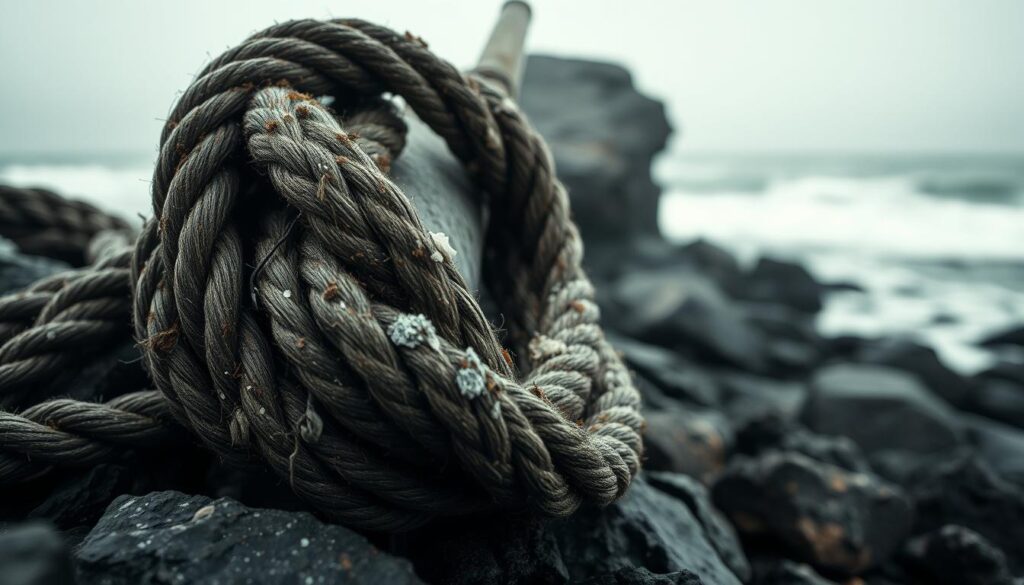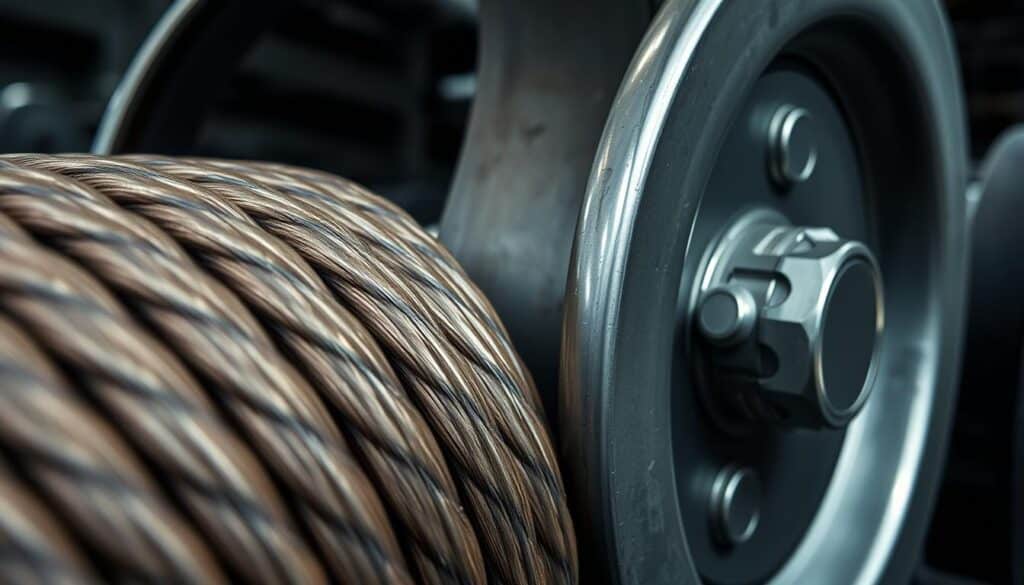Wire rope corrosion is a big problem for industries that need lifting, rigging, and support systems. It happens in places like the sea and industrial sites. Moisture, chemicals, and wear can cause steel cables to deteriorate, leading to expensive failures. This guide will explain why corrosion happens and how to stop it to protect your investments.
Keeping wire cables in good shape is key to fighting corrosion. Saltwater, humidity, and abrasion are common causes. By tackling these issues early, you can make your equipment last longer and stay safe. Taking care of cranes, elevators, or offshore machines can save you time and money.
Key Takeaways
- Corrosion causes include environmental exposure, chemical reactions, and physical wear.
- Proper corrosion prevention requires tailored solutions based on operating conditions.
- Steel cable deterioration often starts at microscopic damage points, accelerating rust formation.
- Regular inspections and lubrication delay the progression of corrosion in wire ropes.
- Selecting corrosion-resistant materials like galvanized or stainless steel improves longevity.
Understanding Wire Rope Basics and Corrosion Vulnerability
Wire ropes are amazing feats of engineering. But, their design and materials make them vulnerable to corrosion. Let’s look at how their construction and materials impact their durability and cost.
Composition and Structure of Wire Ropes
Wire ropes are made of steel wire strands twisted around a core. The carbon steel composition of these strands balances strength and flexibility. Ropes have wire rope core types like fiber cores for flexibility or steel cores for heavy loads.
This layered design has microscopic gaps. These gaps let moisture and chemicals in.
| Core Type | Material | Use Case |
|---|---|---|
| Fiber Core | Synthetic or natural fibers | Cranes, elevators (flexible applications) |
| Steel Core | Wire strands | High-heat environments (mining, construction) |
Why Wire Ropes Are Susceptible to Corrosion
- Exposed steel surfaces: steel wire strands react with oxygen and moisture
- Carbon steel’s sensitivity to chloride exposure
- Core materials that trap corrosive agents
The Economic Impact of Premature Wire Rope Failure
Preventable corrosion costs industries millions annually.
Wire rope failure costs include:
- Replacement expenses: $2,000–$10,000 per incident
- Production downtime: 4–48 hours per failure
- Regulatory fines for unsafe equipment
These figures show why we need to act fast to protect our investments and safety.
Environmental Factors Leading to Wire Rope Degradation
Outdoor conditions can quickly damage wire ropes. To stop this, we need to protect them from humidity effects, temperature fluctuations, and atmospheric pollutants. These factors together can weaken metal surfaces over time.
| Factor | Impact | Common Settings |
|---|---|---|
| Humidity | Moisture triggers electrolytic reactions between strands | Coastal regions, tropical climates |
| Temperature Changes | Expanding/contracting metal cracks protective layers | Areas with seasonal freeze-thaw cycles |
| Industrial Pollution | Acid-forming pollutants like sulfur dioxide | Near factories or high-traffic roads |
In coastal zones, salt-laden air and humidity speed up rust. Industrial sites expose ropes to atmospheric pollutants that form acids with rainwater. Regular checks and the right coatings are key in these places. Here’s how to adapt:
- Use epoxy or zinc coatings in humid regions
- Apply corrosion-resistant lubricants in fluctuating temps
- Select marine-grade materials near saltwater
By taking these steps, we can fight environmental corrosion factors and make wire ropes last longer. Choosing the right solutions for local conditions ensures they stay strong outdoors.
The Chemical Process Behind Wire Rope Corrosion
Wire ropes are in a constant battle against chemicals. It’s important to know how metals react with their surroundings. This helps us understand why some corrosion types are more aggressive.
Electrochemical Reactions Explained
When steel meets moisture, electrons move between anode and cathode areas. This electrochemical corrosion speeds up when different metals touch, like galvanized and stainless. Oxygen in the air helps turn metal ions into oxides, weakening the structure.
Types of Corrosion Common in Steel Cables
- Galvanic corrosion happens when two metals form a battery, with one metal sacrificing itself to protect the other.
- Pitting corrosion starts as small spots that grow into deep holes.
- Crevice corrosion occurs in hidden spots between strands or under dirt.
- Stress corrosion cracking combines metal fatigue with chemical attack, causing cables to split under tension.
How Corrosion Progresses Within Cable Structures
Damage often starts without being seen. Surface rust spreads inward, weakening wires. Pitting and crevice corrosion create stress points that get worse over time. If not caught, stress corrosion cracking can lead to sudden failures before signs are visible.
Saltwater Exposure: The Primary Enemy of Marine Wire Ropes
Marine wire rope in offshore settings is constantly at risk from saltwater corrosion. Saltwater’s chloride ions break through protective layers, making cables conductive and prone to oxidation. This leads to pitting and can cause cables to fail.

Why Saltwater Accelerates Corrosion
Seawater makes marine wire rope a hotspot for corrosion. Chloride ions get past the natural oxide layers, starting electrochemical reactions. Unlike freshwater, saltwater can get into tiny gaps, causing more damage in hidden spots. It’s vital to know this for keeping maritime cables safe.
Protective Measures for Marine Applications
To fight saltwater corrosion, we need to use several strategies. Here are some key ones:
- Galvanized coatings with zinc layers to slow oxidation
- Sacrificial anodes that corrode first, shielding primary cables
- Regular inspections to detect early signs of pitting
| Method | How It Works | Best For |
|---|---|---|
| Stainless Steel Ropes | Nickel-chromium alloy resists chloride ions | Harbor cranes and offshore rigs |
| Self-Lubricating Coatings | Forms a barrier against saltwater penetration | Fishing vessels and tidal energy projects |
| Regular Cleaning | Removes salt deposits that trap moisture | Maritime cable preservation in coastal areas |
Companies like Crosby and Bridon make marine-grade products for salt spray protection. Steps like quarterly checks and using corrosion-fighting lubricants help cables last longer. Taking these steps keeps offshore work safe and running smoothly.
Industrial Atmospheres and Chemical Exposure Risks
Wire ropes in factories and processing plants face harsher threats than outdoor elements. Chemical corrosion resistance is key where ropes meet acid exposure, alkaline environments, or industrial pollutants in the air. These places need special solutions to prevent sudden failures.
- Acids in metal plating baths break down metal bonds over time.
- Alkaline cleaners used in food processing weaken cable surfaces.
- Vapors from chemical plants condense on ropes, speeding up rust.
Companies like WireTech Industries provide coatings for chemical processing safety. Stainless steel ropes resist sulfuric acid, and PTFE coatings block chlorine. Always check if the material is safe for your facility’s chemicals.
“Ignoring chemical exposure risks can void warranties and endanger workers,” warns the National Association of Corrosion Engineers (NACE).)
Regular inspections with NDT tools spot early signs of pitting. Store ropes in sealed containers to avoid corrosive air. Keep maintenance logs updated with SDS data for each chemical your ropes face. Focus on chemical corrosion resistance to extend life and meet OSHA safety rules.
Mechanical Wear and Its Relationship to Corrosion
Wire ropes face constant battles between physical strain and environmental threats. Mechanical wear creates openings for corrosion to start, forming a dangerous cycle. Abrasion damage from rubbing against machinery parts or harsh environments strips away protective layers, exposing fresh metal surfaces to moisture and chemicals. This physical harm doesn’t just weaken the rope—it primes it for faster chemical breakdown.

Sheave wear and crushing forces during operation crack coatings, letting corrosive elements attack the core. Fatigue failure often follows as corrosion pits act like stress concentrators, making ropes snap under normal loads. Regular surface damage inspection breaks this cycle. Spotting mechanical wear patterns early prevents costly failures:
How Physical Damage Fuels Corrosion
- Abrasion damage scrapes away lubricants and coatings, exposing metal to oxygen and moisture.
- Bending stresses from misaligned sheaves create microscopic cracks, which corrosion accelerates.
- Crushing at pulley contact points removes surface passivation layers on stainless steel ropes.
Identifying High-Risk Wear Zones
Focus inspections on areas with frequent friction:
- Sheave grooves: Check for grooves deepening beyond manufacturer specs.
- Rope bends: Look for dark streaks indicating metal loss from repeated flexing.
- Drum contact points: Measure wear thickness loss exceeding 3-5% of the original diameter.
A
“Early wear detection cuts corrosion-related downtime by 40%”
according to the Wire Rope Users’ Manual.
Proper alignment of sheaves and drums reduces mechanical wear patterns. Pairing regular surface damage inspection with lubrication stops corrosion before it starts. Balancing physical protection with chemical defenses gives ropes the longest lifespan possible.
Effective Lubrication Strategies to Combat Wire Rope Corrosion
Proper lubrication is key to fight corrosion. Wire rope lubricants push out moisture and block dirt. The top products mix penetrating oils to get into tight spots and corrosion inhibitors to create strong barriers.
- Petroleum-based lubricants: Offer cost-effective protection in moderate conditions
- Synthetic blends: Resist high temps and chemical exposure
- Specialty formulations: Include corrosion inhibitors for marine or industrial settings
There are three lubricant application methods:
- Pressure lubricators force product deep into strands
- Drip systems for continuous protection in static setups
- Manual brushing for high-access areas
Set a relubrication schedule based on your environment. Busy ports or factories need checks every month. Indoor ropes might last 6–12 months. Always clean ropes before reapplying lubricant for full coverage.
“Neglecting lubrication cuts rope lifespan by 40%,” says a 2023 study by the Wire Rope Technical Board. Consistent care prevents costly replacements.
Follow the manufacturer’s advice when mixing products. Don’t mix penetrating oils with existing coatings unless tested. Regular checks and proper lubrication can double service life and cut downtime.
Protective Coatings and Materials: Choosing the Right Wire Rope for Corrosive Environments
Choosing the right wire rope for tough settings is key. Galvanized and stainless steel cables are top choices for fighting corrosion. This section helps you pick the best option for your project.
Galvanized vs. Stainless Steel Options
Galvanized wire rope has a zinc coating to protect it. Hot-dip galvanized is great for industrial areas, while electroplated is better for smooth surfaces. Stainless steel, like 316-grade, is best for saltwater and chemicals.
Modern Coating Technologies
Today, wire rope with synthetic jackets is strong and durable. Fusion-bonded polymers keep moisture out. Hybrid designs combine polymers with alloys for extra protection.
Cost-Benefit Analysis
- Upfront Costs: Galvanized wire rope is cheaper but might need more checks in harsh places.
- Long-Term Savings: Stainless steel cable costs more but lasts longer in tough spots.
- Composite Solutions: Polymer coated wire is a good middle ground for less exposure.
Think about the whole cost of ownership, not just the initial price. For coastal projects, 316 stainless steel might be worth the extra cost. In warehouses or construction, polymer coatings can save on maintenance.
Inspection and Maintenance Protocols to Detect Early Signs of Corrosion
Regular wire rope inspection is crucial to catch corrosion early. A structured approach using proven methods ensures safety and extends equipment lifespan. Here’s how to implement effective protocols:
Creating an Effective Inspection Schedule
Risk-based schedules focus on ropes in harsh conditions first. Factors like saltwater contact or heavy loads require monthly checks. Use this checklist to set intervals:
- Frequency: Daily for critical lifting ropes
- Environmental exposure: Increase inspections in humid or industrial areas
- Load history: Heavily used ropes need quarterly reviews
- Regulatory compliance: Align with OSHA and ASME guidelines
Tools and Techniques for Thorough Examination
| Method | Use Case | Corrosion Detection |
|---|---|---|
| Visual inspection techniques | Surface rust, broken strands | Surface-level signs |
| Magnetic testing | Internal corrosion in ferrous materials | Non-destructive analysis |
| Ultrasonic testing | Hidden damage in critical components | Deep structural flaws |
Documentation Practices for Regulatory Compliance
Maintenance documentation must track every inspection. Records should include:
- Date, inspector name, and equipment ID
- Observed damage or corrosion levels
- Repair actions taken
- Retirement decisions and rationale
Clear records protect against legal risks and improve future planning.
Conclusion: Extending Wire Rope Lifespan Through Proactive Corrosion Management
A proactive corrosion management program is key to making wire rope last longer. It combines preventive maintenance and lifecycle optimization. This way, it fights off corrosion from the environment and mechanical stress.
Regular checks, proper lubrication, and choosing materials like galvanized or stainless steel help. They lower risks and cut down on maintenance costs. This makes operations safer and equipment more reliable in tough conditions.
Companies that focus on systematic strategies save money. Early action against corrosion through inspections and coatings prevents sudden failures. This approach keeps operations safe and boosts the value of wire rope investments over time.
By taking proactive steps now, businesses protect their budgets and keep workplaces safe in corrosive environments.
FAQ
What are the main causes of wire rope corrosion?
Wire rope corrosion can happen due to moisture, humidity, and chemicals. Mechanical wear and poor lubrication also play a big role in its deterioration.
How does saltwater exposure affect wire ropes?
Saltwater speeds up corrosion because it’s a good conductor. Chloride ions in saltwater can get past wire rope coatings, causing damage over time.
What are the types of corrosion commonly seen in wire ropes?
Wire ropes can corrode in several ways. These include uniform corrosion, pitting, crevice corrosion, and stress corrosion cracking. Each type can lead to failure if not fixed quickly.
Why is lubrication important for wire ropes?
Lubrication is key because it keeps moisture away, stops contaminants, lowers friction, and protects against corrosion. Regular lubrication helps wire ropes last longer and keeps operations safe.
What should be included in an effective inspection protocol for wire ropes?
A good inspection plan should include regular checks, looking for corrosion signs, and using tools like ultrasonic testing. Keeping records is also important for following rules and tracking trends.
How often should wire ropes be lubricated?
How often to lubricate wire ropes depends on where they’re used, how harsh the conditions are, and the rope type. It’s best to have a regular schedule for lubrication to fight corrosion well.
What are protective coatings, and how do they help wire ropes?
Protective coatings, like galvanization or polymers, add an extra layer of protection. They seal the wire rope, keeping moisture and dirt away from the metal.
Can environmental pollutants contribute to wire rope corrosion?
Yes, pollutants like sulfur dioxide and nitrogen oxides can mix with moisture to form acids. This can harm wire ropes. Knowing your local environment helps in choosing the right protection.
